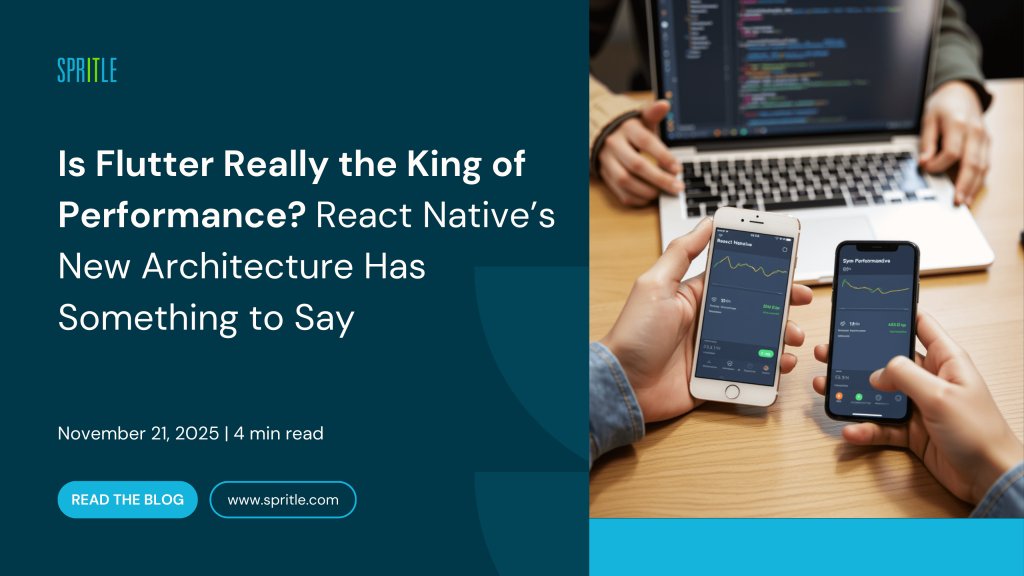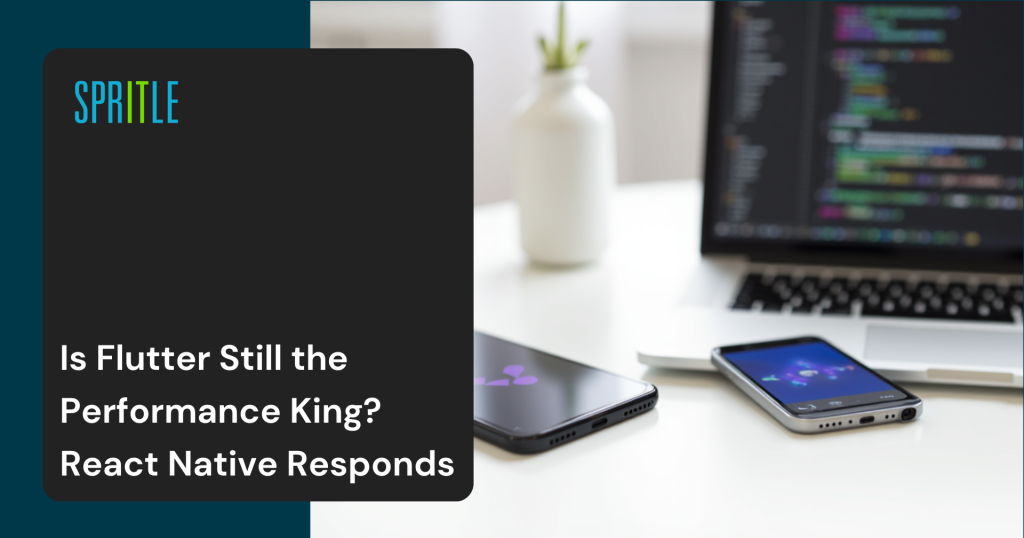
When it comes to cross-platform mobile development, performance has always been one of the hottest debates between React Native and Flutter. Flutter has long been praised as the performance king, but with the recent React Native architectural updates, the story isn’t as one-sided as before. Let’s break it down.
Why React Native’s Performance Was Traditionally Lower Than Flutter
React Native and Flutter approach rendering and communication with the native layer very differently.
React Native (Old Architecture) in Detail
The Bridge Problem
In the old React Native model, your app’s business logic was written in JavaScript, while UI and platform APIs (buttons, navigation, camera, etc.) lived in native code (Objective-C/Swift for iOS, Java/Kotlin for Android).
To connect these two worlds, React Native used a bridge — a communication layer that passed messages back and forth between JavaScript and native modules.
These messages had to be serialized (converted into JSON or similar) before sending, and then deserialized on the other side.

How the Flow Worked
JavaScript Thread → Bridge → Native Modules (UI, APIs) → Screen
- JavaScript handled app logic and events.
- The Bridge carried messages asynchronously.
- Native modules rendered UI and executed platform features.
Why It Slowed Things Down
- Serialization Cost → Each message (like “set button color to red”) had to be converted before sending.
- Async Nature → Messages were queued, so heavy animations or scrolling caused lags.
- Batching & Queueing → Messages were grouped for efficiency, but in UI-heavy apps this caused frame drops.
- Different Threads → JavaScript ran on one thread, UI on another, making sync tricky.
Impact on Performance
- UI-Heavy Apps → Animations and gestures stuttered.
- Platform Variability → iOS and Android sometimes behaved differently.
- Complex Integrations → More native APIs meant more bridging, increasing the performance cost.
👉 In short: the old bridge-based architecture was powerful but created overhead from serialization, batching, and cross-thread communication.
Architectural Flow (Old vs Flutter):

Flutter’s Architecture in Detail
Drawing Every Pixel
Flutter apps are written in Dart, compiled into native machine code, and powered by the Flutter Engine (C++).
Unlike React Native, Flutter doesn’t rely on platform-native UI components. Instead, it renders every pixel using its GPU-optimized rendering engine (Impeller).
How the Flow Works
Dart Code → Flutter Engine → Impeller (GPU Renderer) → Skia Graphics → Screen
- Dart Code defines UI and logic.
- Flutter Engine translates widget trees into rendering instructions.
- Impeller + Skia handle GPU drawing (buttons, text, images, animations).
- Screen displays the same UI across iOS and Android.
Why It’s Faster
- No Bridge → No back-and-forth between JS and native.
- Single Rendering Pipeline → UI is handled fully inside Flutter’s engine.
- Direct GPU Access → Impeller ensures smooth 60fps+ rendering.
- Same Widgets Everywhere → Uniform UI behavior across platforms.
Real-World Impact
- Consistent FPS → Predictable performance across devices.
- Smooth Animations → No stutter from thread-hopping.
- Cross-Platform Uniformity → iOS and Android look identical.
- Handles Heavy UI Easily → Complex transitions and animations run fluidly.
Example Scenario For comparing Flutter vs React Native (Old)
Imagine an app showing a list of 100 images:
- Flutter: Draws everything directly with its GPU-optimized renderer → smooth 60fps.
- React Native (Old):
- JavaScript calculates what to show.
- Sends instructions (like “render image at X position”) over the bridge.
- Native renders it.
- For many items, the constant back-and-forth slows things down → frame drops or delays.
👉 In short: Flutter achieves higher, more consistent performance because it controls the entire rendering pipeline. There’s no bridge, no reliance on OS-native widgets, and direct GPU optimization ensures smooth, predictable results across platforms.
“This is why, It’s been the mantra for years: Flutter always wins on performance. But now, React Native’s new architecture flips the script.”
React Native’s Recent Update: The Bridgeless New Architecture
Facebook (Meta) has overhauled React Native with a new architecture to address these issues. The update introduces:
JavaScript → JSI → TurboModules/Fabric → Native Components → Screen
1. JSI (JavaScript Interface)
- Old Way: In the old bridge model, JavaScript and native communicated through serialized messages (often JSON). This caused delays and overhead.
- New Way (JSI):
- JSI provides direct access between JavaScript and native objects.
- No serialization/deserialization needed — functions and data can be called directly.
- This makes execution faster and closer to native speed.
- Example: Instead of sending a JSON instruction like { “action”: “openCamera” } across a bridge, JavaScript can now call openCamera() directly in native code.
✅ Result: Dramatically reduced latency, smoother performance, fewer dropped frames.
2. TurboModules
- Old Way: Native modules (like Camera, Geolocation, etc.) were loaded eagerly — meaning all modules were initialized at startup, whether used or not.
- New Way (TurboModules):
- Modules are loaded lazily (only when needed).
- They use JSI, so JS can directly access them without bridge serialization.
- Improves startup time and reduces memory usage.
- Example: If your app doesn’t use “Push Notifications” until later, that module won’t load on startup → faster app launch.
✅ Result: Faster startup, lower memory consumption, better runtime efficiency.
3. Fabric Renderer
Old Way (Bridge + Yoga):
React Component → JS Thread → Shadow Tree (Yoga) → Bridge → Native UI Thread → Platform UI
- You write React components (<View>, <Text>).
- React builds a virtual tree (JS representation of UI).
- That tree is converted into a shadow tree — a lightweight copy of the UI structure.
- Yoga runs here to calculate layout (sizes, flex positions, etc.).
- After Yoga calculates layout, the instructions (like width=200, height=50, x=10, y=20) had to be serialized into JSON-like messages.
- These were sent across the Bridge (asynchronous, batched).
- On the native side, they were deserialized back into native objects before rendering.
- It maps them to native UI components (UIButton on iOS, TextView on Android).
- Finally, it draws the UI on screen.
This serialization + deserialization step was the main source of overhead and UI lag.
- New Way (Fabric):
Yoga → Direct (JSI/Fabric) → Native.
- The shadow tree still exists, and Yoga still calculates layout.
- But now, There is No JSON serialization anymore.
- Instead, the shadow tree itself is shared directly between JavaScript and Native using JSI (JavaScript Interface).
- Both JS and Native can access the same in-memory objects (no conversion).
- Example: A complex animation (like swipe-to-delete) now updates smoothly because JS and native UI are tightly synced with fewer hops.
✅ Result: Smoother UI, fewer frame drops, improved animation handling.
4. Codegen
- Old Way: Developers manually wrote bindings to connect JS with native modules. This was error-prone and often lacked type safety.
- New Way (Codegen):
- Automatically generates the boilerplate code for native bindings at build time.
- Ensures type-safe communication between JS and native.
- Reduces human errors and inconsistencies between platforms.
- Example: If a native function expects an integer but JS sends a string, Codegen catches it at compile time.
✅ Result: Safer, more reliable, and faster development workflow.
Architectural Flow (New Architecture):
This bridgeless approach drastically reduces overhead and makes React Native’s performance much closer to Flutter.
Flutter vs React Native: Performance Today
- Flutter: Still has the edge in raw GPU rendering since it controls every pixel and bypasses native widgets entirely.
- React Native (New): Now provides near-native performance with lower latency, better memory efficiency, and smoother UI updates thanks to Fabric and Turbo Modules.
In practice:
- For apps with heavy custom graphics/animations, Flutter may still perform better.
- For apps that rely heavily on native integrations and platform-specific features, React Native now competes strongly without the old performance penalty.
Is “Flutter is Always Better” Still True?
Not anymore.
Flutter still shines with its custom rendering engine and consistent UI performance. But React Native’s New Architecture has changed the game — no more slow bridge, faster UI updates with Fabric, smarter native loading with TurboModules, and seamless type-safe integration via Codegen.
Now, React Native delivers performance that doesn’t just ‘come close’ — it redefines what cross-platform apps can achieve with JavaScript.
👉 So, the old saying “Flutter is always best for performance” doesn’t hold up anymore. With its modernization, React Native is not just catching up — it’s competing head-to-head.
Conclusion
If your top priority is pixel-perfect UI and total control over rendering, Flutter still wears the crown. But the story doesn’t end there. With React Native’s New Architecture, the performance debate is no longer a one-way street. React Native now stands shoulder-to-shoulder with Flutter, proving that it’s not just keeping up — it’s competing at the highest level.
👉 The real truth in 2025: Both frameworks are powerful, battle-tested, and capable of building world-class apps. The old belief that “Flutter always wins in performance” has become more myth than reality.
At the end of the day, your choice isn’t about who wins the performance race — it’s about what fits your team’s strengths, your project’s vision, and your long-term growth.
Because “The future isn’t Flutter vs React Native — it’s what you create with them.”
